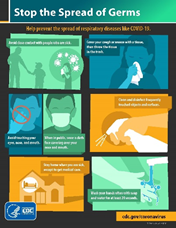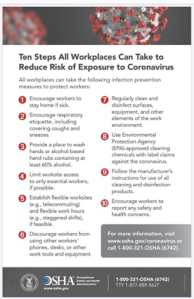COVID-19 is the disease caused by the highly contagious severe acute respiratory syndrome coronavirus 2 (“SARS-CoV-2”) previously called the “novel coronavirus” (World Health Organization). The virus and COVID-19 present serious public health risks. Local and state governments in almost all states have requested the shutdown of non-essential retail services. Many dealerships are keeping their service departments open as part of government recognized “essential service.”
The purpose of this memo is to educate dealership staff to assist in minimizing exposure to the virus and reduce the spread of the disease. We provide this guidance to you for distribution to your management and staff to take proactive steps to help minimize the exposure to the virus. This Covid-19 viral disease is new to all of us. The information you read below may be contradicted in the coming days by advanced knowledge as scientists continue to study the virus. We have reviewed information from government web sites to prepare this memo and recommend that you review information from websites such as www.cdc.gov daily. This memo is not exhaustive. Many advanced ways of protection are available for employees. For example, a fully enclosed body suit with N95 respirator provides greater protection than the PPE currently used in a typical automobile dealership.
Overview
| COVID-19 is a highly contagious, severe acute respiratory syndrome caused by SARS-CoV-2 virusWith high degree of morbidity and fatality compared to seasonal fluSpreads easily and can spread by asymptomatic carriersLocal, State, and Federal governments have shut down non-essential servicesThe CDC recommends distancing of at least six feetThe CDC recommends that all wear cloth face coverings in public settingsView and display this ‘Stop the Spread of Germs’ poster at multiple locations on siteUse the COVID-19 screening tool built by the CDC + FEMA – available in the App StoreInform your HR Manager if you have any symptoms. Follow guidance decisively.Stability of SARS-CoV-2: Information from the National Institute of Health suggests that the virus is very stable and hence contagious. The virus can live up to 3 hours in an aerosol form, 4 hours on copper surfaces, 24 hours on cardboard, and 2-3 days on plastic and stainless steel https://www.nih.gov/news-events/news-releases/new-coronavirus-stable-hours-surfaces |  https://www.cdc.gov/coronavirus/2019-ncov/downloads/stop-the-spread-of-germs.pdf https://www.cdc.gov/coronavirus/2019-ncov/downloads/stop-the-spread-of-germs.pdf |
Management
- Implement a clear and simple HR policy prepared by legal counsel
- Stagger work hours + breaks for all staff (both advisors and techs) to improve social distancing
- Ask HR to manage employee work schedules
- Stagger service appointments and car-pick ups
- Consider non-contact (early bird) kiosk for service drive
- Add a line to the repair estimate for customer approval for vehicle sanitation
- Provide single-use pens for customers to complete paperwork
- Shut down car wash to keep exposure minimal
- Install plexiglass screens to protect employees at customer interface (advisor/cashier/parts counter)
- Close the write-up area to customers or maintain at least six feet distance. Place signs in the drive that require customers to wait for the advisor to come to the car for a write up. This will prevent customer accumulation in the advisor area and maintain necessary distance among advisors and between advisors and customers. Do not allow test drives with customers.
- Ensure HVAC systems operate continually during work hours and annual maintenance is documented. Shop ventilation systems for removal of exhaust must have airflow verified per local regulations.
Organize to Ensure Social Distancing of At Least Six Feet
- Limit access to lunchroom. Ensure display of CDC & OSHA COVID-19 posters.
- May eat at workstations maintaining safe distance and no potential chemical exposure
- Shut down dealer-operated shared transport
- Post notice at entrance:
1. Do not enter if you have cough, fever or other COVID-19 symptoms
2. Maintain at least 6-feet distance from one another
3. Cough into your elbow
4. No physical contact (e.g., handshakes, hugs)
- Monitor Entrance. An employee must monitor entry and the common areas.
- Limit Entrance: Stop visitors outside when facility reaches the capacity that can support 6 foot distancing
- Provide individually packed face covering to customers at no cost and require it be worn. In certain jurisdictions, face covering is mandatory, and it protects us all.
- Use customer lounge/waiting area only if 6-foot distancing is available
- Mandate single person use of elevators
- Post sign: “We have removed food, drinks, etc. to minimize virus exposure & spread of COVID-19”
Organize to Minimize Contact Contagion
- Remove all items that can be touched, be contaminated, and cross contaminate. e.g., coffee cups, coffee machines, toys, magazines
- Provide hand sanitizers and ensure constant sanitizing of common areas
- Shut down car wash to minimize employee contact with vehicles
HR Policy to address all employees including sick and vulnerable employees
To protect all employees and customers, dealers must implement an HR policy prepared by legal counsel. A clear and easy to understand policy regarding employees with COVID-19, employees that have been exposed to others sick with COVID-19 or employees sick with non-COVID-19 illness (e.g., pneumonia, flu, fever, cough, cold) needs to be communicated to all employees immediately. Your HR policy must address vulnerable employees, including and not limited to those with diabetes, pulmonary or heart disease, 65 or older, immune suppressed or pregnant, who are at higher risk of contracting the disease. Policy may include requirement of medical clearance for employees treated for COVID-19.
|
All Employees
|
Janitorial staff
- Train staff to place hand sanitizer (at least 60% alcohol) at locations where their use is most likely
- Use only EPA approved disinfectants. Information at https://www.epa.gov/pesticide-registration/list-n-disinfectants-use-against-sars-cov-2
- Follow the CDC cleaning-disinfection guidelines https://www.cdc.gov/coronavirus/2019-ncov/community/organizations/cleaning-disinfection.html when blending your own disinfectants
- Instruct janitorial staff to sanitize all contact areas repeatedly and replenish soap dispensers, sanitizers, and paper towels throughout the day
- Examples of contact areas requiring cleaning are door handles, door opening plates & elevator buttons, faucets & flush handles, soap and paper towel dispensers, sofas, chairs, other seating areas, and water fountain handles
- Encourage frequent and proper handwashing using the CDC recommended guidelines https://www.cdc.gov/handwashing/when-how-handwashing.html
- Shut down vending machines
Service Writers
- Advise customers in advance of their appointments to be prepared to leave the vehicle at the dealership for service and schedule a later pickup as the waiting lounge has limited capacity with social distancing in effect
- If you are using a touch screen for service orders, sanitize the screen. Use single use pens.
- Ask customers to turn off fan and AC systems in the automobile
Technicians
Customer vehicles may be contaminated. See the COVID-19 stability information above.
Sanitize what you are to touch, touch only what you sanitized, and at the end sanitize all you touched.
 https://www.cdc.gov/vhf/ebola/pdf/poster-how-to-remove-gloves.pdf https://www.cdc.gov/vhf/ebola/pdf/poster-how-to-remove-gloves.pdf |
Technicians must have proper PPE (e.g., nitrile gloves) and must avoid cross-contamination across vehicles. Replace gloves when you finish working on each car using the CDC’s glove removal guidelines. Use a fresh pair for every car https://www.cdc.gov/vhf/ebola/pdf/poster-how-to-remove-gloves.pdfUse covers for steering wheels, shifter and seatsDo not touch any part of your face (eyes, nose, or mouth) or body with your gloves or handsMinimize time inside the cabin. Keep windows down to promote natural air circulation. Keep the fan inside the cabin off as the fan may circulate particles inside the vehicle. Note: virus can be in and on the auto air circulation system.Do not use the vacuum inside the automobile as it may make infectious particles airborneChange in/out of uniform at work daily. Perform basic hygiene functions (e.g., showering) immediately upon returning home and place clothing in wash. |
Respirators/Masks
| Respirators protect from exposure to airborne particles. In healthcare, protects from exposure to biological aerosols including viruses and bacteria. Masks are a barrier to splashes, droplets, and spit. Respirators are designed to seal tight to the face of the wearer. Employees must understand that the mask may not protect them but may reduce the virus load shed by them, in case they are infected but asymptomatic.Use N-95 respirators when they become available for use by the public. Commercially available respirators require the user to be directed to read the packaging on the effectiveness & limitations of the respirator and its proper usage and maintenance. See CDC/NIOSH guidance on How to Properly Put on and Take off a Disposable Respirator Take respirator training. OSHA requires all respirator wearers to undergo mandatory training, fit testing, and medical evaluation. Some exceptions apply under certain circumstances. https://www.osha.gov/laws-regs/regulations/standardnumber/1910/1910.134AppDSome local authorities mandate employees and members of the public wear face coverings/masks when going out to work/outside home. Provide individually packed face covering to customers at no cost and require it be worn. |  https://www.cdc.gov/niosh/docs/2010-131/pdfs/2010-131.pdf?id=10.26616/NIOSHPUB2010131 https://www.cdc.gov/niosh/docs/2010-131/pdfs/2010-131.pdf?id=10.26616/NIOSHPUB2010131 |
DISCLAIMER: Information regarding COVID-19 is dynamic and constantly evolving. Check reliable sources, such as www.cdc.gov, regularly to keep yourself updated, research other areas, and adopt procedures as they deem fit. Even though we have used government sources to prepare this memo, we do not endorse or recommend any for a particular purpose. The information provided here is a brief guidance for employers and employees to undertake in order to protect themselves in the workplace. There is no warranty implied or expressed regarding the completeness or accuracy of information presented here. The information provided here is not complete and/or exhaustive. Protections such as full body sealed suits and N95 respirators will further help reduce risks in the workplace and should be evaluated for use. This memo supersedes all information disseminated earlier.
Employers and employees should understand that the COVID-19 pandemic presents serious life-threatening health risks, and this is guidance on some ways to reduce those risks, not eliminate them. This memo is not intended to constitute medical or safety advice or a substitute for the same. Contact safety consultants, lawyers and medical professionals to take appropriate course of action.
Sam Celly, author, has been assisting dealers with EPA/OSHA regulations for the last 33 years. He received his BE (1984) & MS (1986) in Chemical Engineering followed by a JD in 1997.
Your comments/questions are always welcome. Please send them to sam@cellyservices.com.

One thought on “COVID-19: Minimize Exposure to the Virus & Spread of Disease”